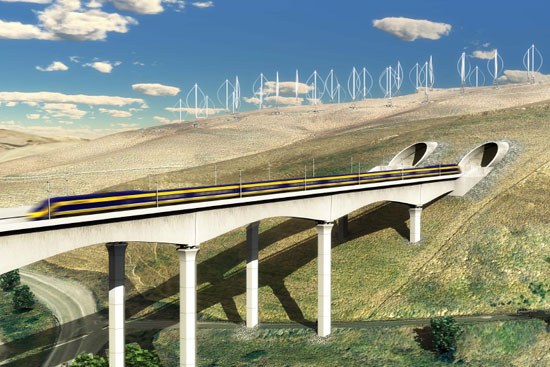Bay Area Won’t Likely Get First High Speed Rail Segment
12:16 PM PDT on November 5, 2010

The California High-Speed Rail Authority (CAHSRA) Board of Directors won't make a decision on where to start building California's first high-speed rail segment until December, but nearly everyone can see the writing on the wall.
Federal Railroad Administration (FRA) Adminstrator Joe Szabo wrote [pdf] CAHSRA CEO Roelof van Ark on Wednesday to inform him that all of the $2.9 billion in federal money given to California's project, including the $715 million awarded last week, must fund either of the two Central Valley segments between Fresno and Bakersfield.
The FRA's letter comes in the middle of the comment period to formalize the segment selection criteria, with the federal government all but deciding the first segment ahead of a formal process. And despite the letter, van Ark said the CAHSRA was committed to objective criteria.
"The selection criteria should be neutral of the four segments," said van Ark at the CAHSRA Board meeting in Sacramento yesterday. "The first step of the process, to select and build the first segment, is really that, it's a first step. Building a high-speed rail line means means connecting metropolitan areas. We have to make a selection that will logically lead us to our final goal. The final goal remains building the complete system."
van Ark suggested his board consider four general criteria for segment selection, with subsections :
- Provide expansion of the alignment to ensure an appropriate operational high-speed system
- Minimize construction risk
- Minimize schedule risk
- Build the most useful high-speed rail infrastructure for the least cost.
Despite these criteria, van Ark noted the obvious, that the state could lose the federal money if it doesn't meet FRA requirements. "At this stage, going by the FRA letter, it would be the selection as together: the Merced-Fresno or the Merced-Bakersfield segment should be built first."
While project supporters like Californians for High-Speed Rail say they support all segments equally and say the CAHSRA must start somewhere, Jose Luis Moscovich, executive director of the San Francisco County Transportation Authority (SFCTA), feared the FRA letter meant the Bay Area had lost out and the decision could hurt the overall project in the eyes of the public.
"I'm the biggest high-speed rail supporter you're going to find anywhere and I believe it will be built and it has to be built," Moscovich told Streetsblog. "The reality is that we have about $13 billion to build something that's going to cost well over $40 billion and we have no clear idea where the rest of the money is going to come from."
Moscovich was concerned about the significance of segment selection and the overall success of the project if the Central Valley sections were first. "Where the initial amount of money gets spent really matters. I'm not sure that by putting the majority of the money in the Central Valley we are going to be able to demonstrate the value of high-speed rail for California," he said.
"It's not just about creating jobs, it's about building the system in a way that makes sense," he continued. "To me, the way that made sense to build the system was to build a demonstration segment between San Francisco and San Jose and another one between LA and Anaheim and have better service in the Central Valley, acknowledging that you can't build the whole system with one fifth of the money."
Moscovitch noted that the Bay Area will be negatively impacted on many fronts if the first segment is in the Central Valley. Infrastructure improvements like electrification of Caltrain and improvement to commuter rail will be delayed and jobs will not materialize. Given that less than a quarter of the total funds necessary to build the project have been identified, controversy around the project hasn't dissipated and new Republican leadership in Washington has vowed to spend less not more, Moscovitch argued there is a risk the Bay Area segment won't be built.
"Up until recently, the Authority was embarked in a process that I think was less than ideal, less than responsive to the concerns of the communities along the right-of-way that has probably generated much self-inflicted pain," said Moscovich. "Now the Authority is working very well with us and others to try to correct those problems, but it's going to take some time to do that. In the meantime, there's going to be a need to spend money that has already been allocated to the Authority for this starter segment and it may be that because of the fact that controversy still exists in parts of the Bay Area right-of- way."
Further, Moscovich said no high-speed rail system in the world has been built without a massive federal government outlay and the private sector cannot be expected to invest the remaining $30 billion or more needed to complete the project if the controversy persists.
CAHSRA officials have until the December board meeting to pick the segment, but board members at the meeting seemed resigned to choosing between two segments.
According to van Ark, that stance wasn't a bad thing and he argued the public shouldn't consider it a competition between segments, but a commitment to a complete system.
"We must remember that this is a high-speed rail system. This not talking, as I know some people are talking, about a segment, a commuter rail line," he said. "This is the beginning of a high-speed rail system that connects southern California to northern California. It is all part of building a high-speed rail system by 2020."
Stay in touch
Sign up for our free newsletter



